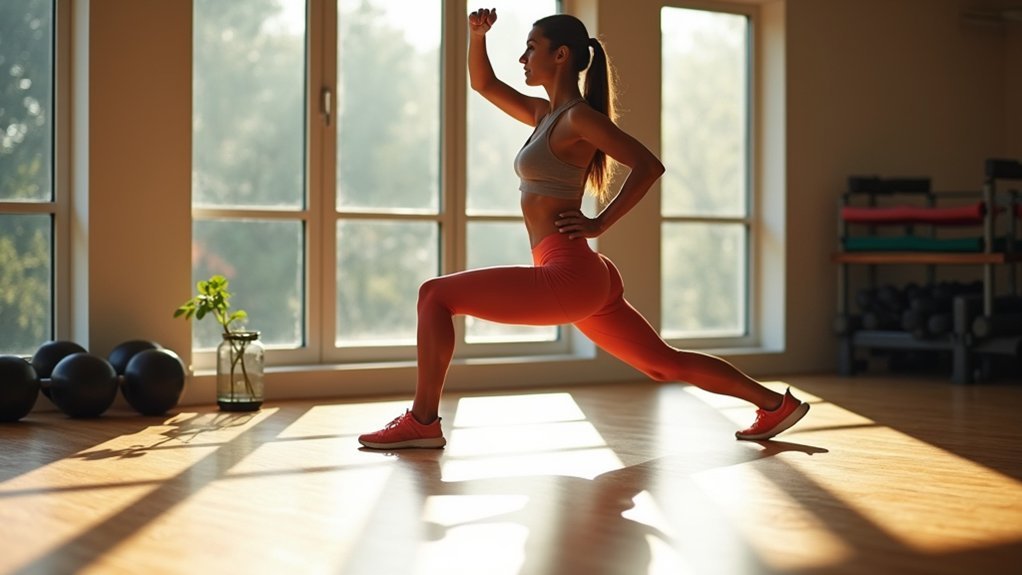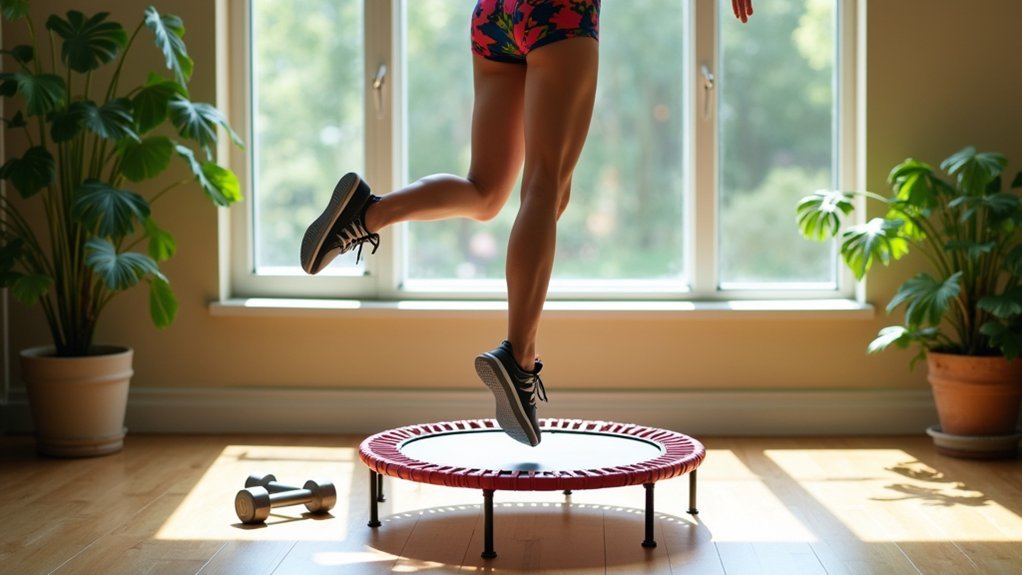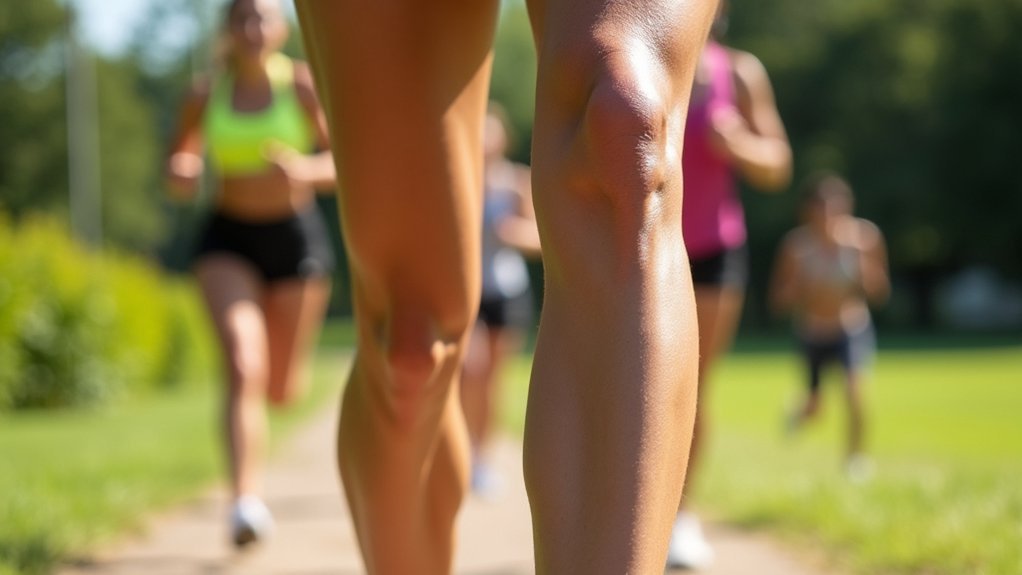Rebounding exercises on a mini-trampoline effectively reduce leg cellulite by enhancing lymphatic flow, improving circulation, and strengthening muscles beneath dimpled skin. Combine basic bounces, knee lifts, and twist combinations for 20-30 minutes, 3-4 times weekly. These low-impact workouts create G-force fluctuations that activate deep lymphatic vessels while toning cellulite-prone areas. For ideal results, pair with proper hydration and anti-inflammatory foods. Discover how this simple exercise can transform your legs with consistent practice.
The Science Behind Cellulite Formation

Dimples, puckering, and the “orange peel” texture that characterizes cellulite result from complex structural interactions beneath your skin.
The primary culprit is the way fibrous connective tissue bands attach your skin to underlying muscles. In women, these bands run parallel, while men’s form a crisscross pattern, explaining why cellulite affects women more frequently.
When fat cells accumulate, they push against your skin while these fibrous bands pull downward, creating the characteristic dimpling.
Hormones play a significant role too—higher estrogen levels contribute to cellulite development, especially during puberty and pregnancy. Your genetics also determine how susceptible you’re to cellulite formation.
As you age, your skin thins and loses elasticity, making existing cellulite more visible regardless of your weight or fitness level.
How Rebounding Exercises Target Stubborn Leg Cellulite
When you perform rebounding exercises, you’re doing much more than simply bouncing up and down—you’re actively engaging your body’s natural detoxification systems.
Your lymphatic system gets a significant boost during these movements, helping to flush out toxins and reduce fluid retention that contributes to cellulite appearance.
This lymphatic flow activation improves circulation to your leg tissues, delivering oxygen and nutrients while simultaneously breaking down the fat deposits that create that unwanted dimpled appearance. The trampoline and vibrating plates create a hypergravity environment that compresses veins and lymph vessels, significantly enhancing drainage in problem areas.
Benefits Beyond Jiggling
Bouncing on a mini-trampoline does far more than just create a fun workout sensation—it strategically combats leg cellulite through multiple physiological pathways.
While you bounce, you’re simultaneously strengthening muscles beneath dimpled skin, providing better structural support to your thighs and hips.
The rhythmic rebounding motion breaks down fascial adhesions that contribute to cellulite’s dimpled appearance while improving your skin’s elasticity.
You’ll also boost detoxification as the exercise enhances lymphatic flow and waste removal from adipose tissues.
Beyond appearance benefits, you’re optimizing body composition by burning calories and maintaining muscle mass during weight loss.
The increased capillary density and improved microcirculation deliver nutrients more efficiently to skin layers while reducing venous congestion in cellulite-prone areas.
Your pelvic floor and core stability improve too, enhancing overall muscle balance and decreasing the risk of varicose veins formation through the stimulation of blood circulation throughout the body.
Lymphatic Flow Activation
Most cellulite-fighting strategies overlook the essential role of your lymphatic system—the body’s natural detoxification network.
Rebounding exercises on a mini-trampoline create unique G-force fluctuations that activate lymph flow in ways static exercises simply can’t match. This gentle bouncing motion creates pressure differentials that flush toxins and reduce fluid retention in cellulite-prone areas.
The rebounding advantage for lymphatic drainage includes:
- Simultaneous activation of both deep and superficial lymphatic vessels during each bounce, reaching areas traditional exercises miss
- Enhanced toxin removal through increased lymph node filtration with just 10-15 minutes of daily jumping
- Improved connective tissue elasticity when you maintain bent knees and incorporate arm movements to maximize drainage
For best results, stay hydrated after your session to support the elimination process.
Top 5 Mini-Trampoline Workouts for Smoother Thighs

If you’re looking to combat cellulite effectively, mini-trampoline workouts might be your secret weapon. These exercises deliver impressive results through lymphatic stimulation and targeted muscle engagement. The rebounding motion creates a near ideal environment for toxin removal through enhanced lymphatic circulation, preventing harmful substances from accumulating under the skin.
Start with Basic Bounce with Knee Lifts to activate your quadriceps while stimulating lymphatic drainage.
Begin with the foundational Basic Bounce with Knee Lifts—your go-to movement for quadriceps activation and enhanced lymphatic flow.
Progress to Pogo Jump Variations, which maximize G-force benefits up to 4G’s and tighten subcutaneous tissue through compression-decompression cycles.
The Spoiled Child Pumping Motion mimics vibrating plate technology, creating rapid muscle contractions that target cellulite directly.
For multidirectional engagement, try Twist Bounce Combinations to break up stubborn fat deposits while working your obliques.
Finally, incorporate Sprint Simulation Drills to boost collagen production and maximize fat oxidation through high-intensity intervals, ensuring continued calorie burn even after your workout ends.
Combining Rebounding With Strength Training for Maximum Results
Combining rebounding with strength training creates a powerful synergistic approach that amplifies your cellulite-fighting results beyond what either method could achieve alone.
This dual-action strategy optimizes fat reduction while enhancing muscle tone exactly where you need it most. Research shows that exercises targeting the glutes, quads, and hamstrings can significantly improve areas where cellulite commonly appears.
For maximum effectiveness:
- Structure your sessions strategically – Begin with 10-15 minutes of rebounding to prime your circulatory system before strength training, or alternate days between each modality to prevent overtraining.
- Leverage complementary benefits – Use rebounding for lymphatic drainage and aerobic conditioning, then target the same areas with compound lifts like squats and deadlifts for muscle development.
- Maintain consistent frequency – Aim for 3-4 rebounding sessions paired with 2-3 strength workouts weekly, using gentle bouncing on rest days for recovery.
The Role of Lymphatic Drainage in Cellulite Reduction

While rebounding and strength training directly target muscle tone and circulation, your body’s lymphatic system plays a fundamental role in the battle against cellulite. This network helps remove trapped proteins and metabolic waste that contribute to the dimpled appearance of cellulite.
Manual lymphatic drainage uses gentle, rhythmic upward strokes (5 repetitions per area) to stimulate fluid movement toward lymph nodes. This technique is particularly effective for edematous, soft cellulite by reducing interstitial fluid pressure that worsens skin dimpling. Practitioners typically begin by focusing on the lymph node areas before moving to the affected tissues, following the natural drainage pathways.
Manual lymphatic drainage: gentle upward strokes that reduce interstitial fluid pressure, effectively targeting edematous cellulite at its source.
Clinical studies show measurable leg circumference reductions after consistent treatments. However, lymphatic drainage works best as a complementary approach alongside exercise and nutrition.
For ideal results, combine it with proper hydration and consider alternating hot/cold showers to enhance circulation between sessions.
Creating a Progressive Rebounding Routine for Visible Results
Rebounding provides one of the most effective exercise modalities for combating cellulite, particularly when structured as a progressive routine that evolves with your fitness level.
Start with gentle bouncing to warm up your muscles, then gradually incorporate targeted movements like squats and side-to-side jumps that specifically address thigh and leg cellulite.
For maximum results, follow these key principles:
- Begin with 5-minute sessions, adding 2-3 minutes weekly until you reach 20-30 minutes.
- Vary your routine by mixing HIIT intervals with steady bouncing to maximize lymphatic flow.
- Challenge yourself by increasing jump height and incorporating resistance bands as you progress.
Consistency is essential—schedule your rebounding sessions at the same time daily and track your progress to stay motivated.
Low-Impact Benefits of Trampoline Exercises for All Fitness Levels
Unlike high-impact exercises that stress your joints, trampoline workouts offer a gentle yet effective approach to battling cellulite.
You’ll experience reduced strain on your knees and ankles while still getting significant muscle-toning benefits, particularly in cellulite-prone areas like thighs and hips.
The rebounding motion strengthens your muscles without excessive pressure on your body, making it ideal if you have joint concerns or are just beginning your fitness journey. Even short sessions create a fat-burning condition that continues to benefit your body long after you’ve finished exercising.
Your bone density improves gradually through consistent use, while your lymphatic system gets a boost—helping flush toxins that contribute to cellulite formation.
What’s more, you can adjust the intensity to match your fitness level, making trampoline exercises accessible whether you’re a beginner or seasoned athlete looking for a low-impact alternative.
Measuring Your Progress: Realistic Timelines for Cellulite Improvement
Many cellulite sufferers become discouraged when they don’t see immediate results from their exercise routines. Real improvement requires patience—expect visible changes after 3-6 months of consistent training, not days or weeks.
Battling cellulite demands persistence—visible results emerge with months of dedication, not overnight.
“Miracle” treatments promising quick fixes simply lack scientific evidence.
Track your progress objectively using these methods:
- Take monthly photos under identical lighting and angles to properly compare texture changes.
- Measure thigh circumference alongside weight tracking to detect body composition shifts.
- Use the pinch test regularly to evaluate improvements in skin elasticity.
For ideal results, aim for 2-3 weekly strength sessions targeting cellulite-prone areas with progressive overload, plus 3-5 aerobic workouts.
Remember that age, genetics, and hormonal status influence your timeline, so focus on consistency rather than comparing your journey to others. Weight loss alone may actually make cellulite more noticeable if loose skin develops, requiring a comprehensive approach to treatment.
Complementary Nutrition Strategies to Enhance Exercise Results
While your exercise routine targets cellulite, your nutrition choices can dramatically amplify those results through strategic anti-inflammatory eating patterns.
You’ll want to pair consistent hydration with electrolytes to support lymphatic drainage and tissue health throughout the day.
Timing your protein intake around workouts helps rebuild connective tissue and improves the elasticity of skin that’s essential for reducing the appearance of cellulite.
Anti-Inflammatory Eating Patterns
When it comes to reducing cellulite, your dietary choices can greatly enhance exercise results by addressing underlying inflammation that contributes to skin texture issues.
The Mediterranean diet, with its emphasis on whole foods, healthy fats, and colorful produce, offers an ideal anti-inflammatory eating pattern that complements your leg-toning workouts.
Try incorporating these anti-inflammatory strategies into your daily routine:
- Replace refined carbohydrates with fiber-rich alternatives like whole grains, beans, and lentils to stabilize blood sugar and reduce inflammatory responses.
- Include omega-3 rich foods such as walnuts, flaxseeds, and fatty fish to combat inflammation at the cellular level.
- Add colorful fruits and vegetables containing antioxidants and phytochemicals that fight free radicals and reduce tissue inflammation.
Hydration With Purpose
Proper hydration forms the cornerstone of any effective cellulite-reduction strategy, working synergistically with your exercise routine to maximize results.
Aim to drink 2-3 liters daily for women and 3-4 liters for men to help flush toxins from fat layers beneath your skin.
When you’re well-hydrated, your skin appears plumper and smoother, diminishing cellulite’s visibility. Both still and sparkling water provide these benefits.
As you exercise, adequate hydration guarantees your body functions efficiently, enhancing circulation to cellulite-prone areas.
To amplify hydration’s effects, reduce salt and sugar intake, which contribute to water retention and inflammation.
Consider incorporating flaxseed for its estrogen-balancing properties and collagen support.
Targeted Protein Timing
Strategically timing your protein consumption can considerably enhance your exercise results when fighting cellulite.
Regular protein intake supports muscle maintenance while promoting fat loss—a critical combination for reducing the appearance of cellulite on your legs.
For ideal results:
- Consume protein within a few hours after your anti-cellulite workouts to support muscle repair and recovery.
- Include collagen peptides in your nutrition plan, as they’re clinically proven to improve skin texture and reduce skin waviness associated with cellulite.
- Space your protein intake every 3-4 hours throughout the day to maximize muscle protein synthesis while supporting fat loss.
The most effective approach is to aim for a daily consumption of approximately 7 grams of protein per 20 pounds of body weight for optimal cellulite reduction results.
Remember that protein timing works best when combined with a calorie deficit and regular exercise targeting cellulite-prone areas of your legs.
Frequently Asked Questions
Can Yoga Effectively Reduce Cellulite Compared to Traditional Cardio?
Yoga can help reduce cellulite through improved lymphatic drainage and targeted muscle toning, while cardio works by reducing overall fat. You’ll likely see best results by combining both approaches in your routine.
Do Specific Supplements Enhance Exercise Benefits for Cellulite Reduction?
Yes, certain supplements enhance exercise benefits for cellulite. You’ll see better results with omega-3s, vitamins C and E, collagen peptides, green tea extract, and alpha lipoic acid combined with your workout routine.
How Does Sleep Quality Affect Cellulite Formation and Exercise Results?
Poor sleep disrupts your hormones, increases inflammation, and slows metabolism, worsening cellulite. When you sleep well, you’ll enhance muscle repair, optimize fat burning, and maintain workout consistency—all critical for your cellulite-reduction efforts.
Can Topical Treatments Improve Results When Combined With Leg Exercises?
Yes, topical treatments can enhance your exercise results. They’ll temporarily improve skin appearance while you’re building muscle and burning fat. You’ll see better results when you combine both approaches consistently.
Are There Genetic Factors That Limit Exercise Effectiveness for Cellulite Reduction?
Yes, your genetics impact cellulite treatment success. You can’t change genetic factors like collagen structure and fat distribution patterns, but you can still achieve improvements by adapting workouts to your specific genetic limitations.
In Summary
You’re now equipped to tackle leg cellulite through effective rebounding workouts. Combine mini-trampoline exercises with strength training to stimulate your lymphatic system and break down fat deposits. Remember, consistency is key. Stick with your progressive routine, complement it with proper nutrition, and you’ll see improvements over time. Don’t get discouraged—these low-impact exercises work for all fitness levels and deliver visible results with patience.





Leave a Reply